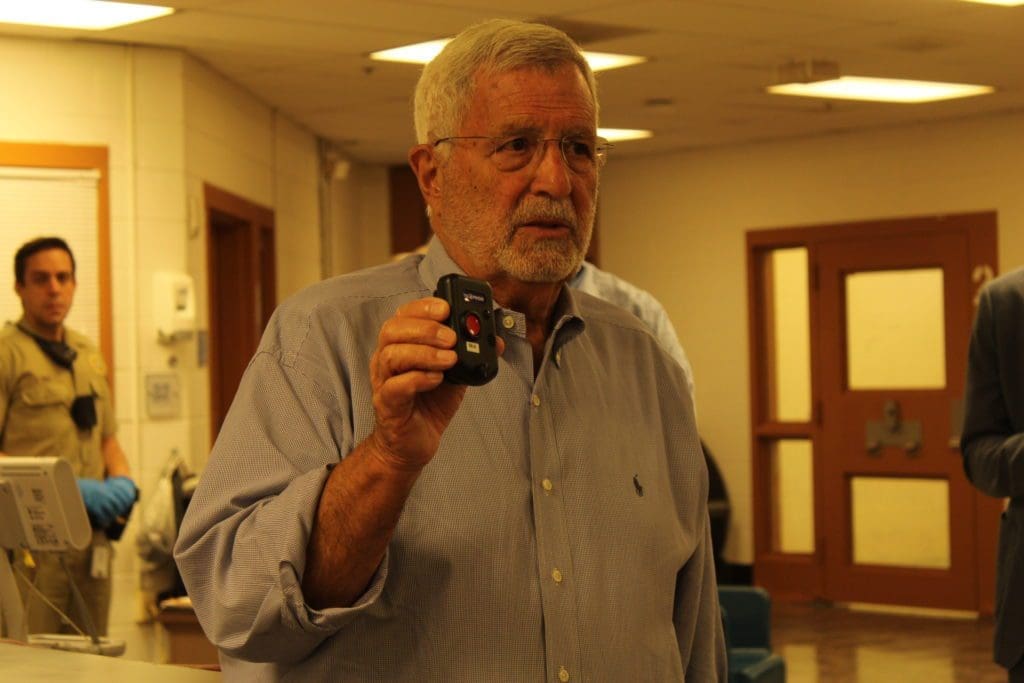By Arielle Robinson
The Cobb County Sheriff’s Office along with the president of Black Creek Integrated Systems demonstrated a new medical tracking and monitoring device for detainees Tuesday morning at the Cobb County Adult Detention Center.
The TSI Prism includes an orange hypoallergenic wrist-mounted device worn by inmates 24/7 and tracks inmates’ locations in real-time.
Cobb Sheriff Craig Owens said that the first phase of implementation starts in June.

In this initial phase, wrist devices will be provided to “at-risk” detainees within the jail’s infirmary.
The devices will monitor heart rate, which can indicate if a person is in distress.
The wrist device sends an “identity-stamped” radio signal every two seconds and an alarm sounds off within 15 to 30 seconds if the device is removed.
Officers and jail staff will also be provided with duress buttons they hook onto their belts and sends an alert out if they are in distress.
These safety devices also send radio signals every two seconds.
A brochure about TSI Prism explains that the device is able to automatically trigger the alarm when an officer is down as well as finding their location and names of detainees in the surrounding area when they went down.
A computer monitor shows inmates’ and officers’ locations and identities.
The next phase of implementation will include expanding the device to every detainee. Every inmate who comes into the facility would be required to wear one. The Cobb ADC holds up to 3,000 detainees.
The device will be able to track inmates within a one to two-meter accuracy anywhere in the facility at any time and provide location history, Black Creek President Isaac Newton said.
Location history would be stored every few seconds.
“[The wrist-mounted device] is a very lightweight device, it has an extended battery life,” Newton said. “It is designed to be waterproof and it is designed for use in a correctional environment. It is secured to the wrist with a special clasp that needs a tool both to install it and to release it and the single most important feature of that technology — it’s somewhat less than half the price of the previous technology.”
The bracelet-like device will cost $100 apiece.
Owens said his office is looking into different grants and ways of funding that would keep the costs low for taxpayers.
“What [the sheriff] has negotiated is that we won’t pay a penny until the sheriff is satisfied with this particular equipment,” Col. Temetris “Pete” Atkins said. “So if it doesn’t work, Black Creek has said that they will just take their stuff back to Alabama.”
Newton said that Black Creek, based out of Alabama, has had similar technology in the past but it was flawed. The technology presented Tuesday is a newer and updated model.
The Cobb Sheriff’s Office will be the first in the country to use this new wrist device for detainees, officials said.

Newton said Black Creek has worked with various correctional facilities for over 30 years.
Newton also presented a tracking device with the same technology as the other devices that attaches to objects, such as a knife, weapons, or a key ring.
If something like a knife were removed from the kitchen, an alarm would go off.
“If you think about what you can do with the tracking, we can [monitor if] an inmate is in an area where they’re not supposed to be in, an officer is in an area where they’re not necessarily supposed to be in,” Newton said. “We can assign risk groups to different inmate tags.
“For example, a person that is vaccinated versus a person that is not COVID vaccinated. If those two inmates get in proximity to one another, we get an alert, so we’re able to do contact tracing with this system as well. It’s an all-purpose system that is designed to assist in the operation of the facility, bring the safety level up, and the officer workload down, so those are our goals.”
Owens said the technology can help make up for short-staffing in the jail.
Newton also spoke about the effectiveness of similar Black Creek technology in the past.
“What we know in prior deployments with the tracking piece is we know that inmate on inmate assaults declined, we know that inmate on staff assaults declined, and operational history becomes far more transparent in a correctional facility — and transparency is very, very hard to come by,” Newton said.
But the elephant in the room was how these tracking devices relate to the deaths that have continued to occur in the jail.
Six people have died in the jail since Owens took office in January 2021, with three of those deaths occurring in May 2022 alone.
Owens confirmed Tuesday that two detainees committed suicide this year while one did not wake from her sleep.
The sheriff estimated that over 70 percent of people in the jail have mental health problems — if that number is not higher.
“No sheriff’s office across the state — we’re not mental health professionals — that’s not what we do,” Owens said. “We’re correctional, and we’re here to hold them until they have their day in court. I’m not here to perform mental health services, but that’s what it’s turned out to be.”
Incarcerated people dying at the Cobb ADC is not new, as 51 people died there throughout the approximately 16 years Owens’ predecessor Neil Warren was sheriff. A number of those deaths occurred among mentally ill people.
When Owens came into office, he pledged to improve mental health services for detainees.
Back in October, Owens announced 24/7 mental health services for people incarcerated, with an emphasis on suicide prevention and help with substance abuse. Cobb was the first county in Georgia to create a program of this kind.
Owens has also instituted a program for incarcerated fathers as well as anger management courses.
Still, as Newton pointed out, suicide is the leading cause of death in jails and inmate-in-custody deaths are on the rise.
A Bureau of Justice Statistics study shows that in 2018, 1,120 detainees died in local jails. This was the largest number of deaths in local jails since the BJS started to collect this sort of data in 2000.
The same study shows that in 2018, suicide was the leading cause of mortality in local jails. Nearly 30 percent of deaths were suicides.
A 2021 report from the Prison Policy Initiative states:
“Suicide in jail tends to happen quickly: half of all those who died by suicide between 2000 and 2018 had been in jail for 9 days or less – compared to a median stay of 17 days for all causes of death. A short stay in jail can be extremely harmful, a fact that even our nation’s top officials acknowledge, noting that ‘certain features of the jail environment enhance suicidal behavior.’ For suicide and deaths linked to drugs or alcohol, it’s those first few days in jail that are deadliest.”
Owens and Newton say they hope these new tracking devices help prevent suicides.
“On these at-risk inmates, if we can catch them at a moment of vulnerability and intercede [and] take action to protect that inmate’s health, we’re going to be able to take some positive steps to reduce in-custody deaths,” Newton said.
Owens clarified that this new technology is not being implemented in light of recent deaths. Rather, it is a project the sheriff’s office has been working on since Owens first took office.
Owens said it is difficult to say whether these devices could have prevented the suicides that already occurred.
“We had six unfortunate incidents of deaths in our facility — and I’m not proud of that,” Owens said. “But if you look around the metro Atlanta, we’re no different from anyone else. I don’t want one death. One death is too many, but when we have people doing things to themselves and want to hurt themselves, it’s very hard for us to try and prevent that.
“We put every precaution into place. We bought new suicide smocks, we bought suicide mattresses, everything you can think of, we’re doing, and spending a lot of money to try to prevent [suicides]. And we will continue to do that. And we’re hoping this technology — hopefully — will help us prevent one.”

Arielle Robinson is a student at Kennesaw State University. She also freelances for the Atlanta-Journal Constitution and is the former president of KSU’s chapter of the Society of Professional Journalists as well as a former CNN intern. She enjoys music, reading, and live shows.
